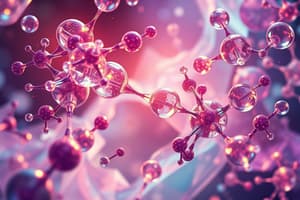Podcast
Questions and Answers
What characteristic do bioisosteres share?
What characteristic do bioisosteres share?
- They possess similar physical properties. (correct)
- They have identical molecular weights.
- They are always hydrophilic.
- They affect unrelated biochemical systems.
Which method is typically used when the target of a drug is unknown?
Which method is typically used when the target of a drug is unknown?
- Qualitative Structure Activity Relationship (QSAR)
- Quantitative Structure Activity Relationship (QSAR) (correct)
- Empirical Drug Design
- Targeted Molecular Simulation
What does the Lineweaver-Burk plot represent?
What does the Lineweaver-Burk plot represent?
- The kinetics of enzyme inhibition. (correct)
- A method for calculating molecular shapes.
- The relationship between bioisosteres and agonists.
- A plot of biological activity versus pharmacological properties.
What defines the interaction between an ion and a solvent molecule?
What defines the interaction between an ion and a solvent molecule?
Who was responsible for an early example linking biological activity to LogP?
Who was responsible for an early example linking biological activity to LogP?
What is the primary purpose of Clog P in medicinal chemistry?
What is the primary purpose of Clog P in medicinal chemistry?
Which of the following correctly describes the term 'pharmacophore'?
Which of the following correctly describes the term 'pharmacophore'?
Which statement about Lineweaver-Burk plots is true?
Which statement about Lineweaver-Burk plots is true?
Which of the following is NOT one of Lipinski's Rules for orally active drug substances?
Which of the following is NOT one of Lipinski's Rules for orally active drug substances?
What is the main characteristic of bioisosteres?
What is the main characteristic of bioisosteres?
What do Van Der Waals forces primarily describe?
What do Van Der Waals forces primarily describe?
What is a notable feature of the angiotensinogen pathway?
What is a notable feature of the angiotensinogen pathway?
What type of interaction does π-cation bonding involve?
What type of interaction does π-cation bonding involve?
Which of these values is critical for blood-brain barrier penetration?
Which of these values is critical for blood-brain barrier penetration?
Which property is essential for bioisosteric compounds?
Which property is essential for bioisosteric compounds?
Which functional group is recognized as a sulfonamide?
Which functional group is recognized as a sulfonamide?
How can you distinguish between conformational and configurational isomers?
How can you distinguish between conformational and configurational isomers?
Which drug is an example of a di-zwitterion in terms of its structure?
Which drug is an example of a di-zwitterion in terms of its structure?
What best explains the concept of Vmax in pharmacokinetics?
What best explains the concept of Vmax in pharmacokinetics?
What is the effect of a higher LogP value on aqueous solubility?
What is the effect of a higher LogP value on aqueous solubility?
What is one characteristic of a lipophilic compound?
What is one characteristic of a lipophilic compound?
Which of the following is true about competitive reversible inhibitors?
Which of the following is true about competitive reversible inhibitors?
What aspect do regio-isomers share?
What aspect do regio-isomers share?
Which bond interaction is typically referred to as salt bridge in biological systems?
Which bond interaction is typically referred to as salt bridge in biological systems?
What is the primary characteristic of competitive inhibitors?
What is the primary characteristic of competitive inhibitors?
Which example represents a transition state analog?
Which example represents a transition state analog?
What is a common feature of irreversible inhibitors?
What is a common feature of irreversible inhibitors?
What defines slow, tight-binding inhibitors?
What defines slow, tight-binding inhibitors?
What mechanism do mechanism-based enzyme inactivators utilize?
What mechanism do mechanism-based enzyme inactivators utilize?
What is the primary action of statins as enzyme inhibitors?
What is the primary action of statins as enzyme inhibitors?
What do affinity labeling agents do?
What do affinity labeling agents do?
What type of inhibitor are sulfa drugs classified as?
What type of inhibitor are sulfa drugs classified as?
Flashcards
Ion-dipole Bonding
Ion-dipole Bonding
Interaction between an ion and a polar molecule, usually a solvent like water.
Π-Cation Interaction
Π-Cation Interaction
Interaction between a positively charged ion and the electron cloud of an aromatic ring.
Pharmacophore
Pharmacophore
A group of atoms within a molecule that is responsible for its biological activity.
Bioisostere
Bioisostere
Signup and view all the flashcards
Sulfonamide Functional Group
Sulfonamide Functional Group
Signup and view all the flashcards
Vmax
Vmax
Signup and view all the flashcards
Km
Km
Signup and view all the flashcards
Inhibitor
Inhibitor
Signup and view all the flashcards
IC50
IC50
Signup and view all the flashcards
Nucleophiles
Nucleophiles
Signup and view all the flashcards
Electrophiles
Electrophiles
Signup and view all the flashcards
LogP
LogP
Signup and view all the flashcards
Van Der Waals forces
Van Der Waals forces
Signup and view all the flashcards
Competitive Inhibition
Competitive Inhibition
Signup and view all the flashcards
Transition State Analogs
Transition State Analogs
Signup and view all the flashcards
Dipole-Dipole Bonding (Hydrogen Bonding)
Dipole-Dipole Bonding (Hydrogen Bonding)
Signup and view all the flashcards
Slow, Tight-Binding Inhibitors
Slow, Tight-Binding Inhibitors
Signup and view all the flashcards
Ionic Bonding (Salt Bridge)
Ionic Bonding (Salt Bridge)
Signup and view all the flashcards
Lipinski's Rules
Lipinski's Rules
Signup and view all the flashcards
Affinity Labeling Agents
Affinity Labeling Agents
Signup and view all the flashcards
Mechanism-Based Enzyme Inactivators
Mechanism-Based Enzyme Inactivators
Signup and view all the flashcards
Blood-Brain Barrier
Blood-Brain Barrier
Signup and view all the flashcards
Irreversible Inhibitor: Michael Acceptor
Irreversible Inhibitor: Michael Acceptor
Signup and view all the flashcards
Disease State Analysis
Disease State Analysis
Signup and view all the flashcards
Quantitative Structure Activity Relationship (QSAR)
Quantitative Structure Activity Relationship (QSAR)
Signup and view all the flashcards
Angiotensinogen Pathway
Angiotensinogen Pathway
Signup and view all the flashcards
Angiotensin-Converting Enzyme (ACE)
Angiotensin-Converting Enzyme (ACE)
Signup and view all the flashcards
ACE Inhibitor
ACE Inhibitor
Signup and view all the flashcards
Lineweaver-Burk Plot
Lineweaver-Burk Plot
Signup and view all the flashcards
Study Notes
Introduction to Medicinal Chemistry
- Course instructor: Mark J. Olsen
- Associate Professor of Pharmaceutical Science
- Phone: (623)572-3568
- Email: [email protected]
- Office: Glendale Hall, Room 236-18
Learning Objectives Hour I
- Determine most and least potent drug from IC50 data
- Understand LogP and its relationship to aqueous solubility
- Judge LogP values based on chemical structure recognition
- Recognize molecular functional groups via Van Der Waals forces
- Review conformation vs. configuration, distinguish conformational and configurational isomers
- Understand the significance of stereochemistry
Why Medicinal Chemistry?
Natural Products versus Synthetic Agents
Drug vs Poison
Drugs Versus Poisons
- Images of poppy, scorpion, and skin wound illustrate varying effects of substances
Origins of Pharmacotherapy
Modern Drug Discovery
- Disease State Analysis
- Specific gene target demonstration
- Expression and Crystal Structure
- High Throughput Screening
- Lead Compound Identification
- Medicinal Chemistry optimization
- Proof of Principle Demonstration
- Pre-clinical Evaluation and Development
- Clinical Trials
- FDA Approval
Physico-Chemical Properties in Medicinal Chemistry
- Hydrophilic: "Water-loving"
- Hydrophobic: "Water-hating"
- Lipophilic: "Lipid-loving"
- Lipophobic: "Lipid-hating" (rarely used)
- Log P (octanol/water coefficient): crucial for determining hydrophilicity/lipophilicity
- Clog P and Mlog P: calculated and experimentally measured Log P
Lipinski's Rules
- Not more than 5 hydrogen bond donors
- Not more than 10 hydrogen bond acceptors
- Molecular Weight (MW) less than 500 amu
- LogP less than 5
- Blood-Brain Barrier Penetration: PSA less than 60Å2, LogP greater than 0
Molecular Interactions
- Van Der Waals forces: Weak forces between nearby covalent bonds. Similar to hydrophobic interactions
- Dipole-dipole bonding: Usually called hydrogen bonding in biological systems.
- Ionic bonding ("salt bridge"): Between ions with opposing charges
- Ion-dipole bonding: Between an ion and a dipole (e.g., water).
- π-cation interaction: Between a cation and a π-cloud of an aromatic molecule, important in drug-protein interactions
Label Each Bonding Example!
- Chemical structures illustrating various bonding examples
Sample Structure Activity Relationship (Part II): Functional Groups, pKa, and Ionization States
- Chemical structures of various functional groups (halogen, ketone, carboxylic acid, aryl amine, alkyl amine), pKa values, and ionization states in stomach and colon.
Stereochemistry and Configuration
- Chemical structures of stereoisomers (R)-(-)-Epinephrine, (S)-(+)-Epinephrine, and N-Methyldopamine are presented.
Enantiomers versus Diastereomers
- Chemical structures of enantiomers (e.g., (-)-Ephedrine, (+)-Ephedrine) and Diastereomers (e.g., (-)-Pseudoephedrine, (+)-Pseudoephedrine) are shown to demonstrate their distinguishing properties).
Regio-Isomers
- Chemical structures of Regio-Isomers are presented
Learning Objectives Hour II
- Review key heterocycles common in drugs
- Define pharmacophore and Structure Activity Relationship (SAR)
- Discuss bioisosteres and provide examples
- Pay close attention to the role of Fluorine
- Recognize Sulfonamide functional groups
- Understand drug-poison relationships and metal chelation
- Defines Vmax and KM
- Evaluate competitive, reversible inhibitors, irreversible inhibitors, and affinity labels
Aromaticity and Common Pharmaceutical Heterocycles
- Chemical structures of various aromatic and heterocyclic molecules (benzene, pyrazine, pyridine, quinoline, indole, indoliIne, benzimidazole, benzofuran, thiophene, furan, pyrrole, imidazole, oxazole, isoxazole, pyran, piperidine, piperazine, morpholine)
Drug Development and Pharmacophore Identification
- Chemical structures illustrating drug development and pharmacophore identification (4,5-Epoxymorphinans, Morphinans, Benzodioxanes, Ethanolamines, Diphenhydramine, Benzomorphans, Phenothiazines (Promethazine), Ethylenediamines, 4-Phenylpiperidines, Methadones, Chlorpromazine (antipsychotic), Tripelennamine)
Sample Structure Activity Relationship (Part I): The role of functional groups
- Chemical structures illustrating various functional groups and their impact on biological activity (halogen, ketone, carboxylic acid, aryl amine, alkyl amine)
- Relationship between functional groups and cellular penetration.
- Correlation between functional groups and pharmacophore, activity spectrum, and potency.
Bioisosteres
- Organic structures that are biologically equivalent in a given system.
- Compunds or groups that possess nearly equal molecular shapes and sizes; similar distribution of electrons; similar physical properties (hydrophobicity)
- Produce biological properties similar to agonists or antagonists.
Common “Classical” Bioisosteres
- Tabulation of monovalent and divalent bioisosteres (e.g., F, H; OH, NH; SH, OH; Cl, Br, CF3), trivalent groups (e.g., -P=, -As=), tetrasubstituted atoms (-P=, -As-), and ring equivalences.)
"Non-Classical" Bioisosteres
- Tabulation of chemical structures of compounds with bioisosteric replacements.
Sulfonamides
- Chemical structures of Sulfonamide and examples of Sulfonamides.
Quantitative Structure Activity Relationship (QSAR)
- Computational method likening physico-chemical properties to biological activities.
- Famous early example using Corwin Hansch who linked barbiturate biological activity to LogP.
- Methodology typically uses biological activity (Y-axis) and physico-chemical property (X-axis) plots.
Structural Biology in Computational Medicinal Chemistry: Captopril and Lisinopril
- Describes the relevance of structural biology to computational medicinal chemistry in terms of Captopril and Lisinopril.
Angiotensinogen Pathway
- Diagram and detailed descriptions of the biochemical pathways, enzymes, and protein sequences involved in the angiotensinogen cascade.
ACE Crystal Structure
- Visual representations (images) of the ACE (Angiotensin-Converting Enzyme) crystal structure, including locations of Zinc, Asp, and His residues relevant to substrate binding.
Development of Captopril
- Chemical structures are presented for Succinyl-L-proline, D-2-methylsuccinyl-L-proline, 3-Mercaptopropanoyl-L-proline, and Captopril.
Captopril Complexed to Active Site Zinc
- Visual representation (image) of Captopril bound to the ACE active site.
Lisinopril: Di-Zwitterion
- Chemical structure showing the Zwitterion form of Lisinopril.
Lisinopril Complexed to Active Site Zinc
- Visual representation (image) of Lisinopril bound to the ACE active site
Enzyme Kinetic Equations
- Michaelis-Menten equation and its graph
- Mathematical expressions and graphic depictions of enzymatic kinetics, including the Michaelis-Menten equation and its plot.
Lineweaver-Burk Equation and Plot
- Lineweaver-Burk equation and its graphical representation.
Kinetics of Enzyme Inhibition
- Explanation of competitive, non-competitive types of enzyme inhibitors.
- Detailed analysis of how the Lineweaver-Burk plot can be used to understand the different modes of enzyme inhibition (competitive, noncompetitive) and related mathematical expressions are presented.
Nucleophiles and Electrophiles
- Definitions and illustrative chemical structures of nucleophiles and electrophiles.
Major Classes of Enzyme Inhibition: Reversible Inhibition
- Different types of reversible enzyme inhibitors (competitive, alternative substrate, transition state analogs, slow, tight-binding) including definitions, examples (sulfa drugs, HIV protease inhibitors, statins), and a discussion of their application in biochemical pathways, with special emphasis on how they compare to each other.
Major Classes of Enzyme Inhibition: Irreversible Inhibition
- Discussion of affinity labeling agents (aspirin, β-lactam antibiotics and their potential for allergic reactions).
- Explanation of mechanism-based enzyme inactivators (e.g., 5-Fluorouracil) with emphasis on their covalent binding characteristic to active site residues.
Irreversible Inhibitor: Michael Acceptor
- Diagrammatic representation of mechanism for irreversible inhibitors and their interaction with enzyme active sites.
Statins: Example of Slow, Tight Binding Inhibitors
- Chemical structures and steps in the biochemical pathway for statin drug mechanism and how they inhibit HMG CoA reductase.
Statin Metabolic Activation and Mechanism of Action
- Detail of how Statin compounds (e.g., mevastatin, lovastatin) are chemically and biochemically transformed to a more active form.
Statin family of antihypercholesterolemia agents are classic examples of enzyme inhibitors
- Chemical structures illustrating the various statin family members, including Lovastatin, Simvastatin, Pravastatin, Fluvastatin, Atorvastatin, and Rosuvastatin.
Studying That Suits You
Use AI to generate personalized quizzes and flashcards to suit your learning preferences.




